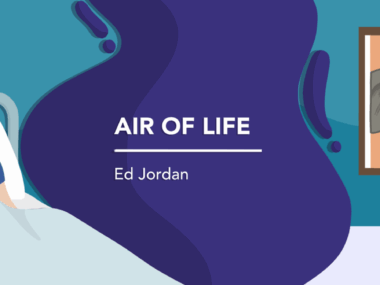Clinical Anxiety of an Unexpected Type
Written by |

Hi, my name is Brad Dell, and I have clinical anxiety disorder.
Well, disorders. Three types.
My generalized anxiety disorder is well-documented in my columns. It’s plagued me since sixth grade, beginning when I’d lie in bed at night, sweaty and staring at the glowy star stuck to my ceiling while thinking about death.
My panic disorder debuted by smacking me around in ninth grade and sending me to the emergency room under the assumption I was having a heart attack.
My self-described clinical-clinical anxiety first hit when my mouth met the pulmonary function test (PFT) machine and I couldn’t exhale. I’d been kissing the darling machine since before memory began sticking to my brain, yet that day, it was like I’d forgotten how to breathe. I removed my mouth from the PFT machine and finally exhaled. I stuck my mouth back on the machine, and … no air. My respiratory therapist checked for a mechanical block preventing airflow. Nope. She stared at me, concerned, and said she’d return the next day to allow my “jitters” to settle.
It was then that I realized I was jittering, trembling as though I’d chugged a 2-liter can of Red Bull. It was July 2016, and I was recovering from a case of septic shock resulting from a vicious port-a-cath infection. My lung function had been cut from about 52 percent to 14 percent in a matter of days. Before then, I’d foolishly allowed myself to think dropping a few percentage points each year wasn’t consequential. I didn’t consider the variables.
The Cystic Fibrosis News Today forums are a place to connect with other patients, share tips and talk about the latest research. Join today!
I sat on my sweaty hospital bed and loathed myself. I’d thought of myself as decently intelligent, yet I’d allowed justifications and loopholes and logical fallacies to prevent me from realizing that I was not safe from my disease. I hadn’t taken care of myself like I should have. Within minutes, a panic attack exploded in my chest.
The next day, the respiratory therapist returned. The moment I saw the PFT machine, I sobbed and begged her to go away. I said we already knew I was dying, that we didn’t need to see some stupid number that would only make me more anxious. What was the point? She eventually left, saying she’d come back later.
We repeated that dance a couple more times.
See, the PFT machine reminded me of my failure and imminent death. Within days, everything in the hospital would remind me of those two things. Once a place of familiarity, the hospital became a place of uncontrollable anxiety. Staying in the hospital for 44 days during that time was absolute hell. I needed to leave; I was desperate to leave. Even looking at once-beloved doctors in their white coats drove me mad. Once, doctors came in and I tried to hide in my closet. I’d devolved into a little boy.
A few months later, I was at a transplant center for lung transplant evaluation. Doctors were concerned about my heart, which had high blood pressure and a rapid heart rate, according to clinic testing. We feared a bad heart would severely complicate transplantation. The doctors did a right-heart catheterization while I was under the soothing influence of anti-anxiety medications, and found my blood pressure was fine. My ultrasound looked fine, too.
The doctors were perplexed. As is often the case, we accidentally stumbled upon the reason for my symptoms.
I needed to take a six-minute walk test (a measure of heart rate and blood oxygenation while walking for six minutes) but the clinic hallway was occupied by another patient doing the same test. So, a respiratory therapist took me outside the clinic area. The test yielded surprising results: a heart rate lower than it was when sitting in the clinic despite the aerobic exercise of walking for six minutes. A light bulb went off in my head and I asked that they retry the test in the clinic. Boom — spiked heart rate. Back to the off-site testing area — a calmer heart.
My doctor, parents, and I laughed, which was a rare occurrence in the evaluation process. I literally had clinical anxiety. (Some call it white coat hypertension.) My heart rate and blood pressure would peak in clinical settings and rest upon leaving them. I theorize that the trend began on the day I first couldn’t take a PFT test.
These days, I tell the story to every nurse who checks my heart rate and asks, “You have an energy drink today?” As someone who is passionate about storytelling, I find that recalling that narrative eases my clinical anxiety. So, we may have wasted thousands of dollars in diagnosing a simple problem, but at least I got a good story out of it that also solves the problem.
Why’d I write about this? Well, I have writer’s block. Also, have you considered the obvious and simple answers to your current medical problems? Maybe you should go take a six-minute walk and think about it.
***
Note: Cystic Fibrosis News Today is strictly a news and information website about the disease. It does not provide medical advice, diagnosis, or treatment. This content is not intended to be a substitute for professional medical advice, diagnosis, or treatment. Always seek the advice of your physician or other qualified health provider with any questions you may have regarding a medical condition. Never disregard professional medical advice or delay in seeking it because of something you have read on this website. The opinions expressed in this column are not those of Cystic Fibrosis News Today, or its parent company, Bionews Services, and are intended to spark discussion about issues pertaining to cystic fibrosis.







Leave a comment
Fill in the required fields to post. Your email address will not be published.